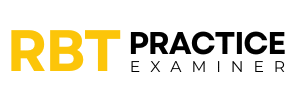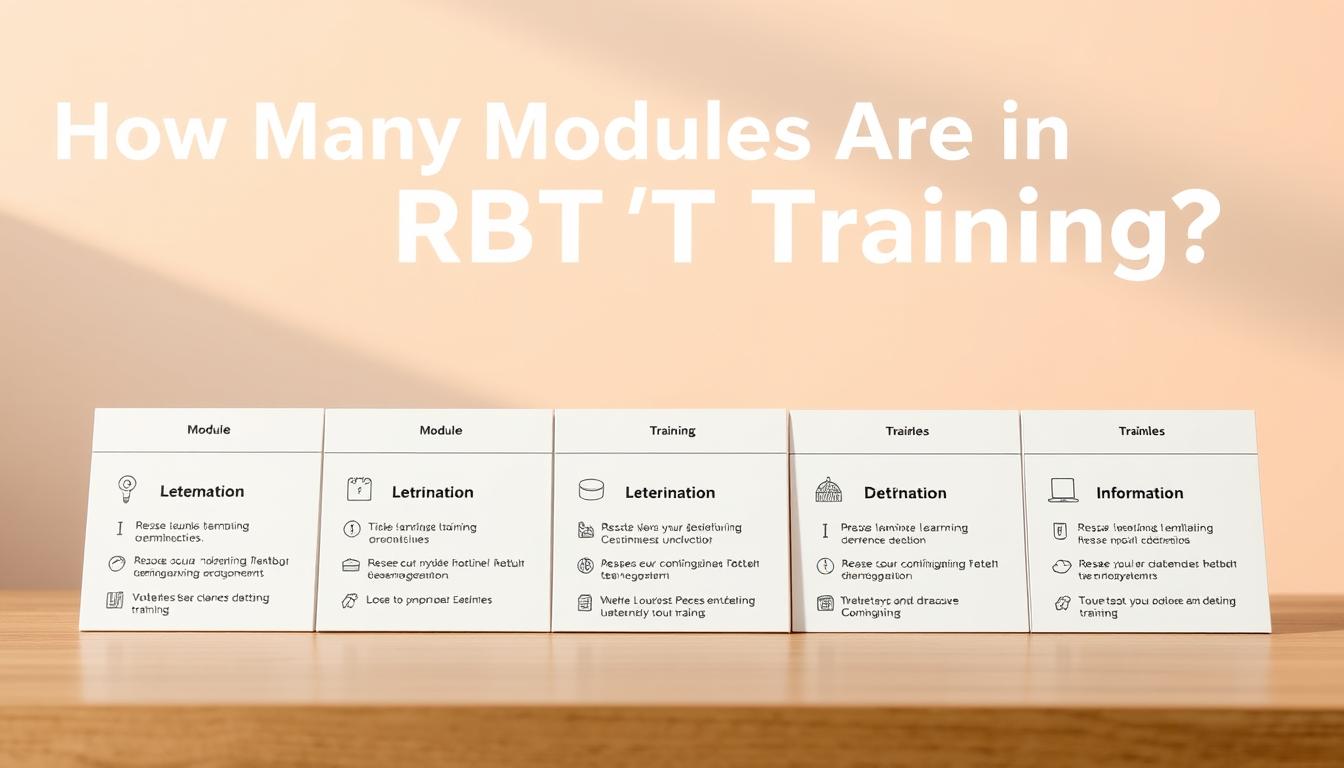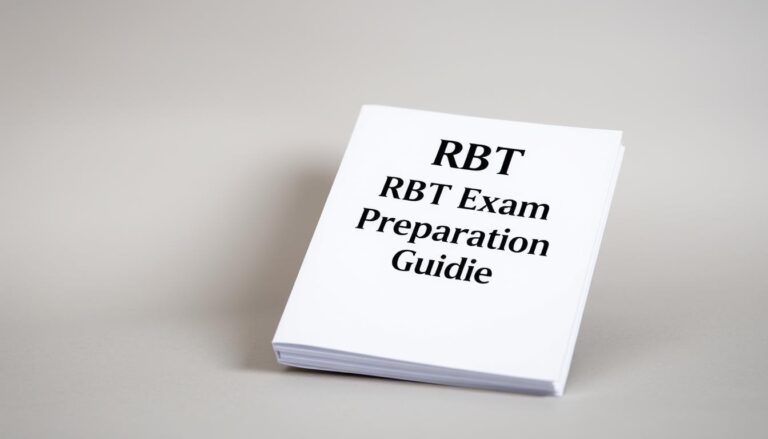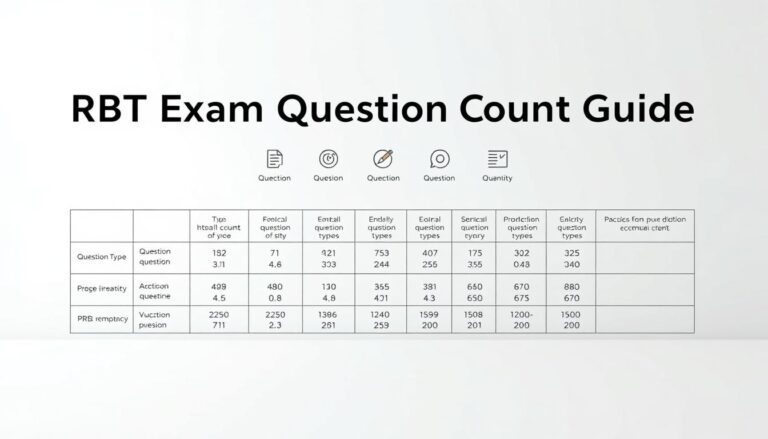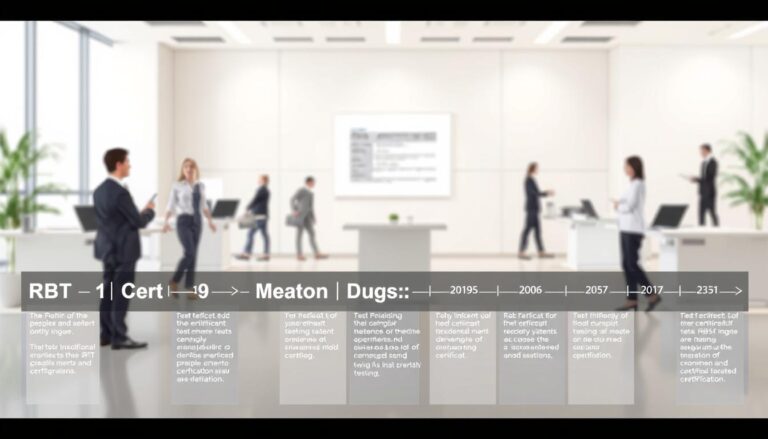How Many Modules Are in RBT Training? Learning While Being True
Starting a career as a Registered Behavior Technician (RBT) needs a clear plan. You must learn the key RBT training modules. This path is for those who want to help others with developmental challenges.
The RBT training has a set number of modules. These modules teach you how to analyze behavior. Knowing how many modules there are is key for those aiming to support individuals with developmental challenges.
We will look closely at the RBT training modules. We’ll cover the important parts that make this training both tough and changing. These modules are the foundation for becoming a skilled professional in behavioral health.
Each RBT training module has its own role. They help train you to make a real difference in people’s lives. You’ll learn how to apply what you’ve learned in real situations.
Understanding the Core Components of RBT Training
Registered Behavior Technician (RBT) training is key for those wanting to help people with behavioral issues. It teaches essential skills in applied behavior analysis through structured modules.
Those aiming to become RBTs go through a detailed training. This ensures they can provide top-notch behavioral intervention services. The training covers many modules to build a strong foundation of knowledge and skills.
Defining Registered Behavior Technician Credentials
RBT certification shows a professional can carry out behavior plans with supervision. Important parts of this include:
- Minimum age requirement of 18 years
- High school diploma or equivalent
- Successful completion of a background check
- Passing a competency assessment
Basic Requirements for RBT Certification
To get certified, candidates must follow several steps. These steps ensure they meet high standards. They include:
- 40-hour training program on key behavioral techniques
- Direct supervision by a Board Certified Behavior Analyst (BCBA)
- Passing the official RBT competency assessment
- Maintaining ongoing professional development
Training Standards and Compliance
The Behavior Analyst Certification Board (BACB) sets strict rules for RBT training. These rules make sure professionals get thorough training. This prepares them for effective behavioral support.
They must show they can handle important tasks like data collection and behavior reduction. The training focuses on skills that work in real-life situations.
The Complete RBT Training Module Structure
Registered Behavior Technician (RBT) certification modules offer a clear path for those new to applied behavior analysis. The rbt course structure is designed to give students all the skills needed for behavioral intervention.
The RBT certification modules cover several important areas:
- Foundational behavioral science concepts
- Ethical guidelines and professional conduct
- Data collection techniques
- Client interaction strategies
- Practical intervention methods
Each module builds on what was learned before, making the education more progressive. Students move from learning theory to applying it, getting a full view of behavior technician training.
The training has tough assessment points to check if students understand. These tests check both their knowledge and how well they can do things practically. This makes sure graduates are ready for the job.
Important topics in the RBT course structure include:
- Understanding behavioral principles
- Implementing intervention strategies
- Documenting client progress
- Maintaining professional boundaries
Students will go on a deep learning journey. They will turn theory into real-world skills in behavior analysis.
How Many Modules in RBT Training: A Complete Overview
Registered Behavior Technician (RBT) training is a detailed program for those wanting to work in behavioral therapy. It’s key to know the modules in RBT training if you’re considering this career.
The RBT training program has five main modules. These modules are made to teach essential skills and knowledge. They help professionals learn about behavioral intervention techniques well.
Module Duration and Structure
Each module in the RBT training program has its own goals and time needs. Here’s what you can expect:
- Foundational Knowledge Module: 4-6 hours of theory
- Professional Conduct Module: 2-3 hours of ethics
- Technical Skills Module: 6-8 hours of practical skills
- Data Collection Module: 3-4 hours of documentation
- Clinical Implementation Module: 5-7 hours of hands-on practice
Module Progression and Sequence
The RBT training modules are set up to follow each other logically. You must finish each module before moving on. This ensures you understand each part fully.
Assessment Requirements
Each module in the RBT training program has its own assessment needs. You’ll show you’re ready by:
- Written exams
- Practical skill shows
- Supervisor checks
- Competency checklists
It usually takes 20-30 hours to finish all the modules in RBT training. This depends on how fast you learn and the program details.
Breaking Down the RBT Curriculum Components
Understanding the rbt module breakdown is key for those wanting to be Registered Behavior Technicians. The RBT curriculum modules give a detailed plan for learning important skills in applied behavior analysis.
The rbt curriculum modules cover several main areas:
- Foundational Behavior Analysis Principles
- Professional Conduct and Ethics
- Data Collection Techniques
- Client Interaction Strategies
- Measurement and Documentation
Each module focuses on specific skills needed for real-world behavioral intervention. The training mixes theory and practice. This ensures technicians can help people with behavioral challenges well.
Key parts of the rbt module breakdown include:
- Comprehensive theoretical instruction
- Supervised practical training
- Skill assessment and verification
- Ongoing professional development
Completing these modules takes hard work, focus, and a real desire to help others. Students learn to observe, record data, and carry out behavior plans.
The curriculum meets high professional standards. It prepares technicians to work in schools, clinics, and private practices.
Essential Skills Covered in RBT Training Modules
RBT training modules offer a detailed plan for learning key skills in applied behavior analysis. They give professionals the tools they need to help those with behavioral issues. This training is essential for effective support.
Those getting RBT certification will learn many specialized techniques. These help improve care and support for clients. The training focuses on practical skills for top-notch therapy.
Behavioral Assessment Techniques
In RBT training, students learn advanced methods for understanding clients. They learn to:
- Spot behavioral patterns
- Find out what triggers behaviors
- Do detailed behavioral observations
- Read complex behavioral signals
Data Collection Methods
Getting accurate data is key in RBT training. Trainees learn to:
- Make detailed behavioral records
- Use standard tracking tools
- Apply objective measurement methods
- Analyze behavioral data
Client Interaction Protocols
RBT training focuses on professional and caring interactions with clients. Students learn important communication skills, such as:
- Building trust and rapport
- Using positive reinforcement
- Keeping professional boundaries
- Adjusting communication to fit each client’s needs
These detailed RBT training modules make sure professionals are ready to offer top-notch behavioral support.
Time Investment for RBT Module Completion
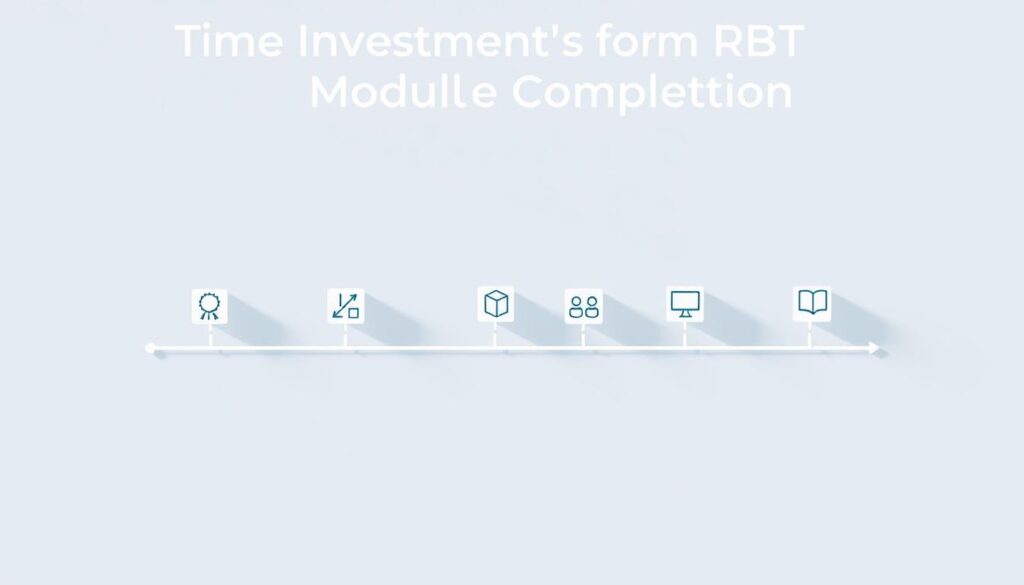
Those aiming to become Registered Behavior Technicians (RBTs) need to think about the time it takes to finish their training. The time needed varies based on how you learn and your personal life.
The RBT training has 4-6 modules. Most people spend about 40-50 hours on training. This includes:
- Initial training curriculum
- Supervised practical experience
- Competency assessment
- Final certification examination
Here’s how the time is usually split:
- Initial Training: 24-30 hours of structured learning
- Supervised Experience: 5-10 hours of direct observation
- Competency Assessment: 2-3 hours of skill verification
- Certification Exam: 1-2 hours of testing
Students can choose to train full-time or part-time. Part-time learners might take 2-3 months. Full-time students can finish in 4-6 weeks.
Several things affect how long it takes to complete the training. These include your past experience, how fast you learn, and the availability of training resources. It’s important to plan your schedule well to finish the modules successfully.
Module-by-Module Learning Objectives
Understanding the RBT course structure is key. It helps turn aspiring behavior technicians into skilled pros. Each module is designed to build both knowledge and practical skills.
The rbt module breakdown focuses on three main areas:
- Theoretical foundations of applied behavior analysis
- Practical intervention strategies
- Ethical professional conduct
Theory and Conceptual Understanding
The theoretical parts of RBT training go deep into behavioral science. Students learn about:
- Behavioral assessment techniques
- Learning mechanisms
- Psychological foundations of behavior modification
Practical Application Skills
Practical skills are essential for effective behavior intervention. Trainees learn how to:
- Collect data
- Use direct behavior intervention strategies
- Interact with clients
Professional Ethics and Conduct
Ethical practice is critical in behavioral health. The RBT course structure teaches professional standards. These standards protect client rights and ensure quality care.
By mastering these learning objectives, RBT candidates gain the knowledge and skills needed. They can make a real difference in clients’ lives.
Online vs. In-Person RBT Training Modules
Choosing the right format for RBT training modules is key. Both online and in-person training have their own benefits for those wanting to be Registered Behavior Technicians.
Online RBT training modules offer great flexibility. They let students learn at their own pace. You can access the materials from anywhere with internet.
- Flexible scheduling
- Self-paced learning
- Accessible from any location
- Often more cost-effective
In-person training, on the other hand, provides direct interaction with instructors. It offers immediate feedback and hands-on learning.
- Direct instructor interaction
- Immediate skill correction
- Structured learning environment
- Real-time collaborative learning
The best training method depends on your learning style and schedule. Some might like a mix of online and in-person training.
Make sure the training meets the Behavior Analyst Certification Board (BACB) standards for RBT certification.
Assessment Methods Across RBT Modules
To become a Registered Behavior Technician (RBT), you must pass tough tests in many areas. The RBT certification modules have special tests to check if you know your stuff and can do the job well.
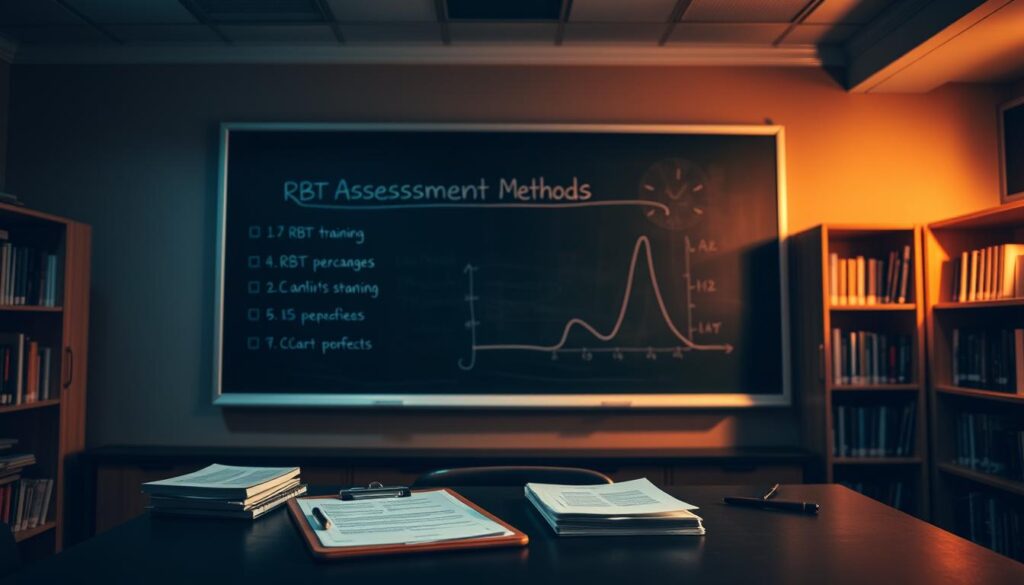
The RBT curriculum has three main ways to check if you’re ready and skilled in applied behavior analysis.
Written Evaluations
Written tests are the first step in RBT certification. They cover a lot of ground with questions like:
- Behavioral principles
- Ethical guidelines
- Client interaction strategies
- Data collection techniques
Practical Demonstrations
After the written tests, you’ll show off your skills in real-life situations. You’ll need to:
- Show you can use behavioral intervention techniques right
- Record data correctly
- Talk to clients in a professional way
- Follow the right steps when interacting with clients
Competency Checks
The last step is a detailed check by experienced supervisors. They make sure you’re ready to be a top-notch RBT who can really help your clients.
Each test helps make sure you’re a skilled behavior technician. You’ll be ready to make a big difference in people’s lives.
Prerequisites for Each Training Module
Starting the rbt training program requires preparation and knowing what you need to begin. Before you start each module, you must meet certain requirements. This ensures you learn well and move forward successfully.
The first steps in RBT training need specific qualifications. These qualifications are the foundation for your education as a behavioral technician. You’ll need:
- Minimum age requirement of 18 years
- High school diploma or equivalent educational certification
- Clear background check and criminal history screening
- Completion of initial online orientation course
Professional readiness is key to moving forward in RBT modules. You must show:
- Basic understanding of applied behavior analysis principles
- Strong communication skills
- Emotional stability and patience
- Commitment to ethical professional conduct
Each module in the rbt training program builds on what you’ve learned before. You must finish the basic modules before moving on to harder ones. This way, you develop all the skills needed and keep professional standards high.
If you’re thinking about becoming an RBT, check the program’s requirements carefully. Different training providers might have extra needs beyond these basic ones.
Navigating Through the RBT Training Process
Becoming a Registered Behavior Technician (RBT) needs careful planning and knowing the training modules. The RBT module breakdown has several steps. These steps help future professionals learn key skills in applied behavior analysis.
Getting through RBT training well depends on good scheduling and tracking progress. Pros need to manage their learning well to fully develop their skills.
Module Scheduling Options
When looking at RBT training modules, there are many flexible scheduling options:
- Online self-paced learning
- Weekend intensive workshops
- Evening classes
- Hybrid training programs
Progress Tracking Systems
Today’s RBT training programs have advanced tracking systems to follow learning progress:
| Tracking Method | Features |
|---|---|
| Digital Learning Platforms | Real-time progress monitoring |
| Performance Dashboards | Skill assessment tracking |
| Mentor Check-ins | Personalized feedback sessions |
These tools help professionals improve their learning experience and stay motivated during their RBT certification journey.
Common Challenges in RBT Module Completion

Starting RBT training can be tough for those wanting to become behavior technicians. Knowing the challenges helps students get ready and find ways to finish their training.
Students face several big hurdles in their RBT training:
- Time management complexities
- Balancing professional and personal commitments
- Comprehending complex behavioral concepts
- Maintaining consistent study motivation
When figuring out how many modules are in RBT training, students often find the curriculum too much. Getting ready well is key to beating these challenges.
Here are some ways to tackle common problems:
- Create a structured study schedule
- Join peer support groups
- Utilize online learning resources
- Practice active learning techniques
- Seek mentorship from experienced RBT professionals
Being resilient and flexible is essential for finishing RBT training modules. Students who tackle challenges head-on are more likely to get their certification.
Support Resources for RBT Training Modules
Getting through RBT certification modules can be tough. But, there are many support resources to help you succeed. The right tools and guidance can make your learning experience better and boost your confidence in becoming a Registered Behavior Technician.
Completing RBT curriculum modules well needs good preparation and access to support systems. Professional groups and training providers offer many resources to help you on your learning path.
Study Materials and Guidelines
Good study materials are key to mastering RBT certification modules. Some important resources include:
- Comprehensive training manuals
- Online learning platforms
- Practice examination guides
- Interactive digital workbooks
- Recorded webinar series
Mentorship Opportunities
Getting help from experienced mentors can really help you understand RBT training modules better. They offer insights through:
- One-on-one coaching sessions
- Professional networking groups
- Virtual supervision platforms
- Peer support communities
Connecting with seasoned professionals can help you deal with RBT curriculum module complexities better. These mentorship programs give you personalized guidance, practical advice, and emotional support during your certification journey.
Career Advancement Through RBT Modules
Registered Behavior Technician (RBT) training modules open doors to growth in the behavioral health field. By finishing a detailed rbt course, you unlock many career paths. These go beyond just starting jobs.
The skills you learn in RBT training can lead you in many exciting ways:
- Advanced clinical roles in autism intervention
- Special education support positions
- Behavioral therapy specialist tracks
- Applied Behavior Analysis (ABA) research opportunities
Those who take RBT training modules become key players in healthcare and education. Your hard work in mastering these modules shows your dedication and skill.
Typically, your career will grow in steps:
- Get your initial RBT certification
- Gain experience in behavioral intervention
- Go for advanced certifications
- Focus on specific areas of behavioral health
Healthcare groups see the value in well-trained RBTs. Knowing the rbt course structure well makes you a strong candidate. This is in a field that helps people with developmental issues.
Conclusion
Understanding the RBT module breakdown is key for those wanting to be behavior technicians. Each module is a step towards becoming better in applied behavior analysis. You’ll learn a lot, turning theory into skills needed for working with autism and developmental challenges.
Being a Registered Behavior Technician means mastering each part of your training. The modules teach you important skills, ethics, and how to work with clients. With hard work, you’ll grow both personally and professionally in behavioral therapy.
Seeing your training modules as more than just school is important. They are a chance to learn and grow, helping you make a real difference in people’s lives. Use every chance to learn, get help from mentors, and keep improving your skills.
Becoming a skilled Registered Behavior Technician takes time, effort, and a love for learning. Knowing the RBT module structure sets you up for a fulfilling career. It’s all about being dedicated to each module and the impact you can make in helping others.
